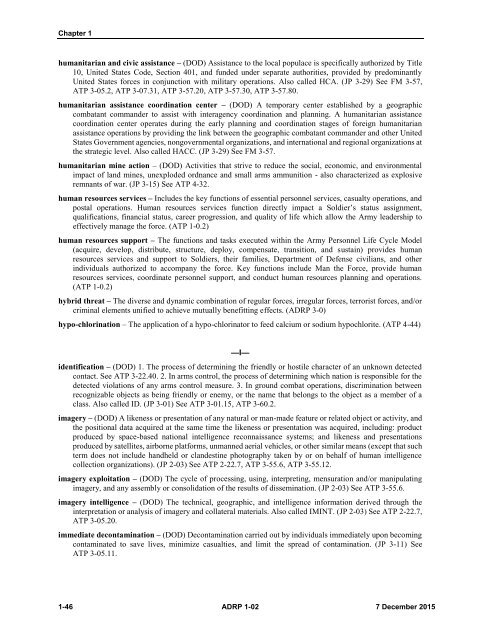ADRP1-02
52543f77c16bcfa46f6e1de2B038ef195
52543f77c16bcfa46f6e1de2B038ef195
Create successful ePaper yourself
Turn your PDF publications into a flip-book with our unique Google optimized e-Paper software.
Chapter 1<br />
humanitarian and civic assistance – (DOD) Assistance to the local populace is specifically authorized by Title<br />
10, United States Code, Section 401, and funded under separate authorities, provided by predominantly<br />
United States forces in conjunction with military operations. Also called HCA. (JP 3-29) See FM 3-57,<br />
ATP 3-05.2, ATP 3-07.31, ATP 3-57.20, ATP 3-57.30, ATP 3-57.80.<br />
humanitarian assistance coordination center – (DOD) A temporary center established by a geographic<br />
combatant commander to assist with interagency coordination and planning. A humanitarian assistance<br />
coordination center operates during the early planning and coordination stages of foreign humanitarian<br />
assistance operations by providing the link between the geographic combatant commander and other United<br />
States Government agencies, nongovernmental organizations, and international and regional organizations at<br />
the strategic level. Also called HACC. (JP 3-29) See FM 3-57.<br />
humanitarian mine action – (DOD) Activities that strive to reduce the social, economic, and environmental<br />
impact of land mines, unexploded ordnance and small arms ammunition - also characterized as explosive<br />
remnants of war. (JP 3-15) See ATP 4-32.<br />
human resources services – Includes the key functions of essential personnel services, casualty operations, and<br />
postal operations. Human resources services function directly impact a Soldier’s status assignment,<br />
qualifications, financial status, career progression, and quality of life which allow the Army leadership to<br />
effectively manage the force. (ATP 1-0.2)<br />
human resources support – The functions and tasks executed within the Army Personnel Life Cycle Model<br />
(acquire, develop, distribute, structure, deploy, compensate, transition, and sustain) provides human<br />
resources services and support to Soldiers, their families, Department of Defense civilians, and other<br />
individuals authorized to accompany the force. Key functions include Man the Force, provide human<br />
resources services, coordinate personnel support, and conduct human resources planning and operations.<br />
(ATP 1-0.2)<br />
hybrid threat – The diverse and dynamic combination of regular forces, irregular forces, terrorist forces, and/or<br />
criminal elements unified to achieve mutually benefitting effects. (ADRP 3-0)<br />
hypo-chlorination – The application of a hypo-chlorinator to feed calcium or sodium hypochlorite. (ATP 4-44)<br />
—I—<br />
identification – (DOD) 1. The process of determining the friendly or hostile character of an unknown detected<br />
contact. See ATP 3-22.40. 2. In arms control, the process of determining which nation is responsible for the<br />
detected violations of any arms control measure. 3. In ground combat operations, discrimination between<br />
recognizable objects as being friendly or enemy, or the name that belongs to the object as a member of a<br />
class. Also called ID. (JP 3-01) See ATP 3-01.15, ATP 3-60.2.<br />
imagery – (DOD) A likeness or presentation of any natural or man-made feature or related object or activity, and<br />
the positional data acquired at the same time the likeness or presentation was acquired, including: product<br />
produced by space-based national intelligence reconnaissance systems; and likeness and presentations<br />
produced by satellites, airborne platforms, unmanned aerial vehicles, or other similar means (except that such<br />
term does not include handheld or clandestine photography taken by or on behalf of human intelligence<br />
collection organizations). (JP 2-03) See ATP 2-22.7, ATP 3-55.6, ATP 3-55.12.<br />
imagery exploitation – (DOD) The cycle of processing, using, interpreting, mensuration and/or manipulating<br />
imagery, and any assembly or consolidation of the results of dissemination. (JP 2-03) See ATP 3-55.6.<br />
imagery intelligence – (DOD) The technical, geographic, and intelligence information derived through the<br />
interpretation or analysis of imagery and collateral materials. Also called IMINT. (JP 2-03) See ATP 2-22.7,<br />
ATP 3-05.20.<br />
immediate decontamination – (DOD) Decontamination carried out by individuals immediately upon becoming<br />
contaminated to save lives, minimize casualties, and limit the spread of contamination. (JP 3-11) See<br />
ATP 3-05.11.<br />
1-46 ADRP 1-<strong>02</strong> 7 December 2015


